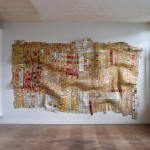 Man’s cloth II
Man’s cloth II
 Man’s cloth II
Man’s cloth II
 Man’s cloth II
Man’s cloth II
 Man’s cloth II
Man’s cloth II
 Man’s cloth II
Man’s cloth II
El Anatsui
107 87/100 x 176 77/100 x 9 3/50 in
Further images
Internationally acclaimed, El Anatsui is one of the most exhilarating contemporary visual artists to have emerged from Ghana, West Africa. Distilling through his revolutionary vision, Anatsui develops unique methods of creation and fantastical fabric manipulation, effectively creating powerful works which address a vast range of social, political and historical topics. Man's Cloth II from El Anatsui's iconic bottle-top installations is a mesmerizing multi-colored tapestry, created from thousands of aluminum liquor bottle-tops which form gleaming metallic planes laden with meaning and references. Transforming found objects into fine art, Anatsui's cloths cause the observer to examine their preconceptions of waste material, its relationship to beauty and how art cannot be confined to strict definitions. A work on the threshold of painting and sculpture, the work exits as a material document of the postcolonial economy of West Africa.
This series was originally conceived subsequent to the artist examining the contents of a household rubbish can, in which he found numerous vibrantly colored metal screw tops of liquor bottles from local distilleries. He collected these from several bins and began to manipulate the materials which he had collected. The artist’s exquisite textiles are formed from hammered, cut, and folded caps; which are then sewn together with copper wire, giving the sculpture freedom of movement, leading to breath-taking manipulations of light and shadow. Susan Mullin Vogel notes, "All drapings create a kind of visual dissonance, between the plastic forms of the draping and the graphic forms of the compositions. Just as viewers see first the whole tissue, then the individual tesserae of Anatsui's suspended sculptures, they simultaneously apprehend dramatically lit and shadowed volumes overlaid by lines and colors that bear no compositional relationship to them" (Susan Mullin Vogel, “El Anatsui: Art and Life”, New York, 2012, p. 130). Within his works, the artist skillfully evokes the recognized aesthetics of painting without the application of physical paint. This distinctive method produces metal carpet works such as Man's Cloth II on an epic scale which succeed in inspiring awe within the viewer.
The repurposed debris of alcohol consumption reminds its viewers that from the late nineteenth century to the post-World War II independence movements, distilled alcohol and bottled beer was one of the most lucrative colonial trade items in sub-Saharan Africa. Known for its breweries and distilleries, Nigeria is the center of regional alcohol production, and thus provides an endless supply of raw material for the artist.
Opulent and monumental like a Byzantine mosaic, Man’s cloth II features rows of gold, white, red and multihued strips of shiny aluminum caps that were straightened, flattened, perforated, and linked together with stitches of copper wire by dozens of assistants in Anatsui’s studio. Pieced in blocks and assembled from sections until it reached its final form, Man’s cloth required a slow, meticulous, and collective production process.
"[My chosen media] are sourced from my immediate environment; they have been put to intense human use. They are thought to have lost value. They are ignored, discarded or thrown away ... To me, their provenance imbues or charges them with history and content, which I seek to explore in order to highlight certain conditions of mankind's existence, as well as his relationship with himself and the environment. I therefore try to bring these objects back, to present them again in ways which seem to make them confront their former lives and the lives of those who have used them." - El Anatsui
The Ghana-born Anatsui is based in the university town of Nsukka in southeast Nigeria, where had has been teaching sculpture since 1975. After initially working with clay and wood to create sculptures that were regularly exhibited in Europe and Japan, Anatsui adpoted the discarded liquor caps as his primary material in 1998. Since their introduction at the international traveling exhibition Africa Remix, in 2004, the monumental wall reliefs have remained widely praised and highly popular, culminating in the artist winning the Golden Lion for Lifetime Achievement at he 56th Venice Biennale in 2015.
In an interview, Anatsui explains that the present work’s predecessor, Man’s Cloth, which is now displayed in the British Museum’s Sainsbury African Galleries, was one of the first works directly stemming from the influence of Ghana’s famed Kente cloth, both in title and design. As the successor to Man’s Cloth, the present work alludes to the cultural history of Ghana, weaving the mutual histories of past and present into one and exemplifies the artist’s ability to imbue an enchantingly fluid tapestry with a rich and wonderful heritage. In Man's Cloth II, Anatsui effectively creates contemporary art with antiquated qualities connecting the individual and collective histories of the African continent; referencing its history, consumption, and globalization.
A work that relies on the flexibitily of its material, Man’s cloth II is also adaptable in and on itself – shifting its shape and voluptuous folds with each installation as a nomadic form open to change.
Provenance
Acquired directly from the artist in 2006Property from the Kalahari Art Collection, 2006 - 2014
Sotheby's, New York, 12 November 2014, lot 460
Private collection, acquired at the above











